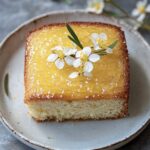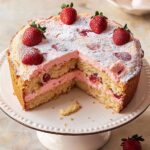The sweet-tart harmony of strawberries and rhubarb comes together beautifully in this old-fashioned jam recipe. Bright lemon juice brings balance, while a touch of pectin ensures a soft, luscious set. Whether you’re spreading it on morning toast or swirling it into yogurt, each spoonful delivers pure seasonal joy.
Homemade Strawberry Rhubarb Jam is a timeless favorite that celebrates the fleeting beauty of spring produce. With just a handful of ingredients and a bit of stirring, you can bottle up the best of summer to savor year-round. Perfect for gifting, preserving, or simply enjoying yourself, this jam captures sunshine in a jar.
Full Recipe:
4 cups fresh strawberries, crushed
2 cups chopped fresh rhubarb
1/4 cup bottled lemon juice
1 package (1-3/4 ounces) powdered fruit pectin
5-1/2 cups sugar
Directions:
In a Dutch oven, combine the crushed strawberries, chopped rhubarb, and lemon juice. Stir in the fruit pectin.
Bring the mixture to a full rolling boil over medium-high heat, stirring constantly.
Stir in the sugar all at once, and return the mixture to a full rolling boil. Boil hard for 1 minute, continuing to stir.
Remove the pan from heat and skim off any foam.
Ladle the hot jam into six sterilized hot half-pint jars, leaving 1/4 inch of headspace.
Remove any air bubbles by tapping the jars gently or using a spatula. Adjust headspace if necessary.
Wipe jar rims clean, apply lids, and screw on the bands until fingertip tight.
Place the filled jars in a canner with simmering water, ensuring jars are fully submerged.
Bring the water to a boil and process for 10 minutes. Remove jars and allow them to cool on a towel or rack.
Prep Time: 10 minutes | Cooking Time: 5 minutes | Total Time: 15 minutes
Kcal: 95 kcal per 2 tablespoons | Servings: Makes 6 half-pint jars
The Story Behind Strawberry Rhubarb Jam
Strawberry Rhubarb Jam is one of those timeless preserves that evoke nostalgia and seasonal joy in every spoonful. This jam is not just a pantry staple but also a vivid symbol of the fleeting beauty of spring and early summer. Its sweet yet tangy profile perfectly captures the flavor harmony between two iconic ingredients: strawberries and rhubarb.
Rhubarb, often misunderstood as a fruit, is technically a vegetable, known for its celery-like stalks and signature tartness. Paired with the natural sweetness of ripe strawberries, the two create a symphony of taste that’s both refreshing and bold. Historically, rhubarb has been used for medicinal purposes, dating back to ancient China. It didn’t gain culinary popularity until it arrived in Europe and North America, where cooks discovered its potential when combined with sugar and fruit.
The practice of making jam from seasonal produce is centuries old, rooted in both necessity and tradition. Before refrigeration, preserving fruit in sugar was a vital way to extend shelf life and enjoy summer’s bounty throughout the year. Strawberry Rhubarb Jam, in particular, has remained a favorite not just because of its taste, but because it reflects the best of two overlapping growing seasons.
Why Strawberry and Rhubarb Work So Well Together
Strawberries bring natural sweetness, vibrant red color, and a fruity aroma, while rhubarb adds a tart, citrus-like acidity and earthy undertone. When combined, the flavors balance out beautifully—neither one overpowering the other. This balance is key to the jam’s widespread popularity. It’s not overly sweet, and it avoids the cloying intensity that some single-fruit jams can have.
Texturally, strawberries break down into a smooth, syrupy base, while rhubarb softens to a tender pulp. Together, they create a luscious spread with body and richness that works perfectly on toast, scones, or biscuits.
The Importance of Timing and Freshness
Because both strawberries and rhubarb have relatively short peak seasons, the best jam is made fresh during late spring to early summer. This is when strawberries are juicy, fragrant, and deep red in color, and rhubarb stalks are firm, bright, and tart. Picking these ingredients at their prime ensures the most flavorful and colorful result.
Canning and preserving them as a jam allows you to enjoy the essence of this short window of time all year long. Many home cooks see this as a form of edible memory-making—sealing a moment in a jar to open again on a colder day.
Why Use Bottled Lemon Juice and Pectin
When making any jam, especially those with lower natural acidity like strawberries and rhubarb, acid balance is crucial not just for flavor, but for preservation safety. That’s why bottled lemon juice is used instead of fresh. Unlike fresh lemons—which can vary in acidity—bottled lemon juice has a standardized citric acid level, ensuring your jam is safely preserved and sets properly.
Pectin, a plant-based starch, helps jam gel to the correct consistency. Strawberries are naturally low in pectin, and rhubarb has slightly more, but not enough to achieve a solid set on its own. Adding powdered fruit pectin ensures the jam thickens correctly, giving it the signature soft-spreadable texture that’s perfect on breads and pastries.
Creative Ways to Use Strawberry Rhubarb Jam
While the most traditional use of Strawberry Rhubarb Jam is simply spread on toast, its versatility makes it an excellent ingredient in a wide variety of dishes.
Use it as a glaze over grilled chicken or pork for a fruity twist. Swirl it into yogurt or oatmeal for a quick flavor boost. Add it to baked goods like thumbprint cookies or sandwich it between cake layers for a vibrant filling. You can even melt it slightly and drizzle over ice cream, pancakes, or waffles.
For a more gourmet touch, pair it with soft cheeses like brie or goat cheese on a charcuterie board. The acidity from the rhubarb cuts through the creaminess of the cheese beautifully.
Small Batch vs. Large Batch: What’s Best for You
This jam is often made in small batches to preserve flavor, texture, and color. Large batches can be harder to control in terms of achieving a proper set and maintaining quality. With small batch recipes, you also minimize waste, making it perfect for those new to canning or those with limited fridge and pantry space.
Small batches also allow for customization. Want to add vanilla or cinnamon? Or perhaps a bit of orange zest for brightness? A smaller volume gives you the freedom to experiment and personalize the flavor to your liking.
Tips for Successful Jam Making
Even though jam-making is relatively simple, a few tips can help ensure success every time:
Sterilize your jars and lids before use to prevent contamination and spoilage.
Always bring your mixture to a full rolling boil before adding sugar and again afterward. This ensures pectin activation and proper thickening.
Skim off foam after boiling. Foam doesn’t affect flavor, but it can look unappealing and interfere with proper sealing.
Leave the correct headspace in jars (about 1/4 inch) to allow for expansion during processing.
Process in a water bath for the full time specified. This ensures the jars seal properly and preserves shelf life.
Strawberry Rhubarb Jam Variations to Try
While the classic combination of strawberries and rhubarb is unbeatable, there are some fun and delicious ways to customize your jam.
Add blueberries: Replace 1/3 of the strawberries with blueberries for a richer berry flavor and deeper color.
Spiced version: Add a cinnamon stick or a few cloves while cooking for a warm, spiced version.
Citrus twist: Add orange zest or a splash of orange juice to elevate the brightness.
Low sugar option: Use a low-sugar pectin and adjust sweeteners for a lighter, fruit-forward jam.
These variations allow you to tailor your jam to your preferences or the season’s offerings.
Storing and Shelf Life
Properly canned and sealed Strawberry Rhubarb Jam will keep for 18 to 24 months in a cool, dark pantry. Once opened, refrigerate and consume within 30 days. Always label your jars with the date of canning to ensure you’re using the freshest ones first.
If you didn’t process the jars in a boiling water bath, they should be stored in the refrigerator immediately and used sooner rather than later. While freezer storage is possible, it’s rarely necessary if jars are sealed properly.
Health and Nutritional Perspective
While this jam is high in sugar—necessary for preservation and proper gelling—it can still be enjoyed in moderation as part of a balanced diet. The fruit content offers small amounts of vitamin C, fiber, and antioxidants, especially from strawberries.
If you’re watching your sugar intake, consider reducing the sugar slightly or using sugar alternatives and low-sugar pectin. This way, you can enjoy the flavor and benefits of homemade jam without overdoing the sweetness.
Conclusion: A Jar Full of Tradition and Taste
Strawberry Rhubarb Jam isn’t just a recipe—it’s a seasonal ritual, a celebration of spring’s finest offerings, and a connection to the comforting tradition of home preserving. Whether you’re new to canning or a seasoned jam-maker, this delightful preserve is a perfect entry point. It teaches balance, patience, and the joy of preserving food the old-fashioned way.
This jam stands as a testament to how simple ingredients—when prepared with care—can create something lasting, meaningful, and delicious. A jar of Strawberry Rhubarb Jam is more than a condiment; it’s a reminder of warm kitchens, fresh harvests, and the sweet-tart beauty of seasonal cooking.
Whether you spoon it onto warm biscuits, give it as a heartfelt gift, or save it for a winter’s morning, this jam promises to bring a little burst of sunshine into your day.






